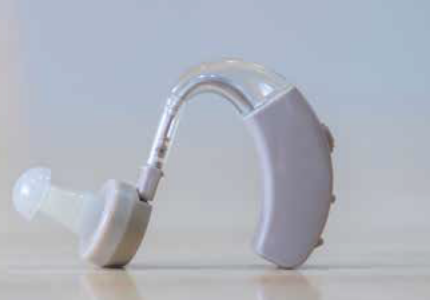They’re now more affordable and available
by Richard Holmes, Sandwich, Massachusetts
 If you’re straining to hear what people say, or find yourself cranking up the volume on your TV to the point others find loud, you probably need hearing aids.
If you’re straining to hear what people say, or find yourself cranking up the volume on your TV to the point others find loud, you probably need hearing aids.
High-frequency hearing loss, often mild, may occur in more than half of people with FSHD, but estimates vary. Hearing loss can be more profound in the early-onset form.
It’s difficult to determine if hearing loss in an adult with FSHD resulted from dystrophy, other causes, or a combination, as hearing loss is common in the general population. More than 15% of Americans over 18 have hearing loss, according to the National Health Interview Survey. The problem increases with age. Almost 80% of people over 70 have hearing loss, says the National Council on Aging.
The good news is that hearing aids have become easier to obtain and cheaper to buy. In August 2022, the US Food and Drug Administration issued a rule allowing direct sale of hearing aids to consumers without requiring a medical exam and doctor’s prescription or a fitting by an audiologist. These hearing aids are only for people with mild to moderate hearing loss. The rule aims to lower prices through marketplace competition, and you’ve probably seen the TV commercials for these devices.
Coverage and price
Price has been a major obstacle to obtaining hearing aids, which many private health insurance plans and standard Medicare don’t cover. However, some Medicare Advantage plans do cover them. And for children up through age 21 enrolled in Medicaid, hearing aids are covered in about half of the nation’s states. If you’re eligible for Veterans Affairs benefits, you may obtain hearing aids, be fitted by an audiologist, and have them maintained at no cost.
If you’re considered disabled because of FSHD but wish to work, you may qualify for government assistance to obtain hearing aids, as well as other assistive devices or services. In Massachusetts, where I live, MassAbility (formerly the Massachusetts Rehabilitation Commission) oversees this function. Some nonprofit organizations recycle hearing aids and may pay for a one-time service, such as an audiology appointment. Financial eligibility requirements may apply.
According to the National Council on Aging, the new over-the-counter (OTC) hearing aids cost about $1,600 on average. Some cost less and go for hundreds of dollars. In contrast, models available through audiologists cost $5,000 to $7,000.
Whatever the price, models vary in design (behind the ear, in the ear, hidden in the ear canal) and options such as Bluetooth connection to a phone app, battery lifespan, and whether batteries are rechargeable or not, as well as availability of online support. Do some research and read independent reviews before you buy.
Although buying a set of OTC hearing aids doesn’t require first seeing an otolaryngologist or an audiologist, it’s still a good idea to have your hearing evaluated by a professional if you can afford to do so. Testing by a medical professional determines the degree and range of hearing loss, and an initial test establishes a baseline that future tests can be checked against to see if your loss is progressing and in what areas. Audiologists can clean and repair your hearing aids, and may check your ear canals for any wax buildup.
Hearing loss hurts
Maybe you think that you don’t need the expense and bother of hearing aids, and can do just fine without them. Think again. Hearing loss is associated with greater risk of dementia. It may cause affected people to interact less with others, leading to isolation that also contributes to developing dementia and poor mental health. Depression, anxiety – even a greater chance of falls – are associated with hearing loss, according to the National Council on Aging.
Fortunately, regular use of hearing aids can improve a person’s psychological and social condition, says the American Speech-Language-Hearing Association. Hearing aids can’t restore hearing. But boosting the volume of the frequencies you’re missing makes a huge difference.
A doctor told me years ago after viewing my hearing test results that I probably had trouble differentiating F from S sounds, or understanding people with higher-pitched voices (typically, women and children). In fact, I frequently misheard or misunderstood what my wife was saying. Trying to hold up my end of a conversation in a noisy restaurant was challenging. Getting hearing aids has greatly enhanced my life.
On average, Americans with hearing loss wait 10 years before seeking help. Reasons for stalling can be cost, vanity, or just being unaware of the options. Given the downsides of going without treatment – and the lower-cost, sleeker options now available – it makes sense to address the problem once you recognize it – not later. Help is out there.


My husband has hearing aids which he purchased at Costco for approximately half the price of purchasing them elsewhere. Plus, near the end of the warranty time, Costco encourages customers to bring in the hearing aids to be sent out for servicing. The servicing usually provides another 3 or so years of hearing aid use. Imagine our surprise today—-he didn’t get his old pair back—-the company replaced them with a new set!! Not all hearing aid companies provide that service but apparently two or three companies do. What a bonus!